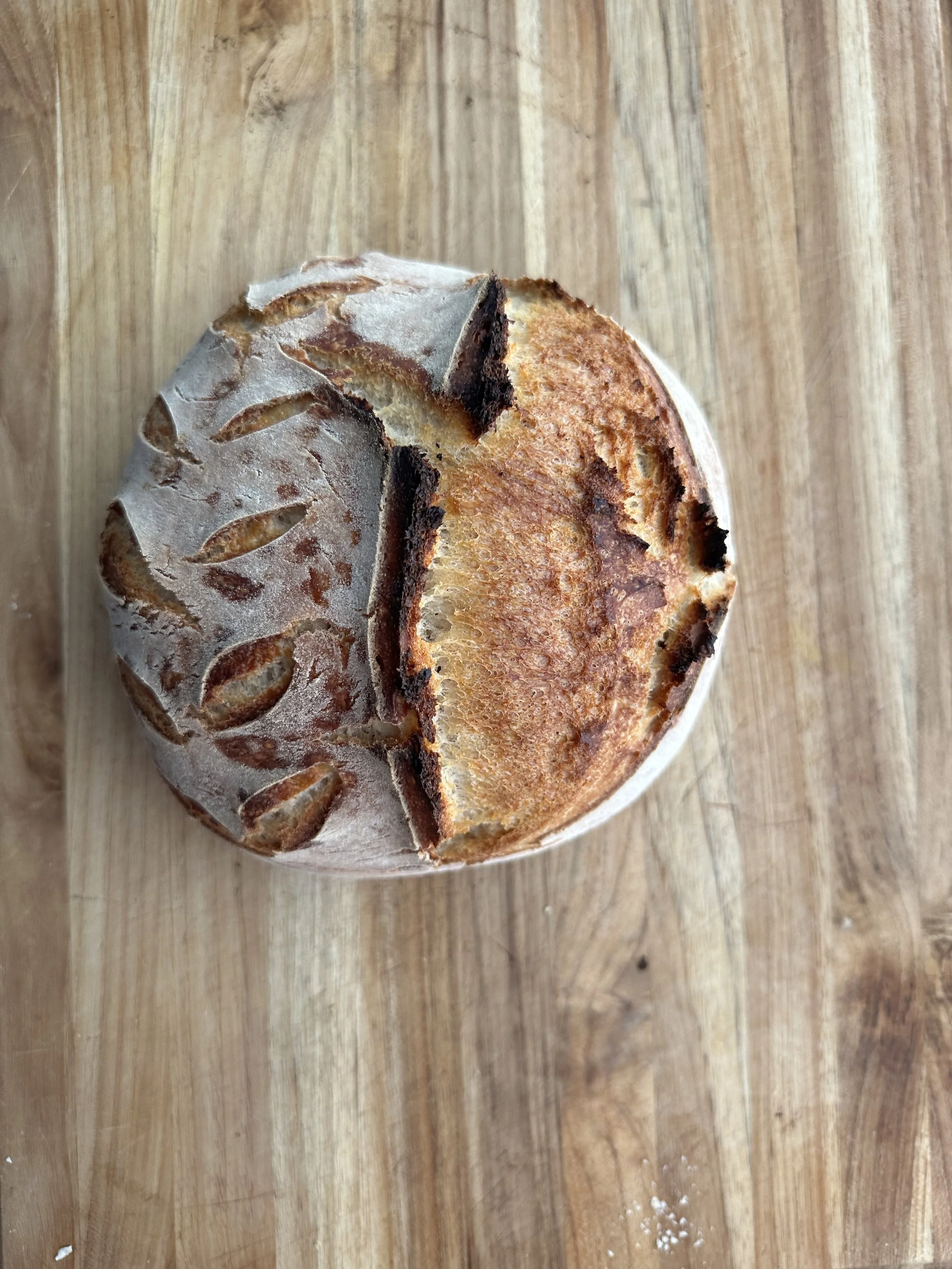My Sourdough Bread Recipe
Sourdough Bread
I’ve always been captivated by the art of sourdough bread. There’s something magical about how just flour, water, and salt can come together to create a perfectly crusty loaf with a distinct tang and airy texture. The process of nurturing a sourdough starter feels like a beautiful balance of science and tradition, and every loaf brings its own set of challenges and rewards. Beyond the craft and history, though, what draws me in even more are the health benefits. As you all know, I’m always mindful of what I put into my body, and sourdough is a fantastic addition to a wholesome diet. It’s not just delicious, but also nutritious, offering benefits that make every bite even more satisfying.
Sourdough bread offers a variety of nutritional benefits, making it a healthier option compared to many other types of bread.
1. Higher Digestibility
Prebiotics and Probiotics: The fermentation process used to make sourdough increases the presence of prebiotics and can create probiotic-like effects, improving gut health and digestion.
Lower Gluten Content: Sourdough naturally breaks down some of the gluten in the flour during fermentation, making it easier to digest, especially for those with mild gluten sensitivities.
2. Rich in Nutrients
Vitamins: Sourdough is a good source of B vitamins, particularly niacin (B3), thiamine (B1), and folate (B9), which are important for energy production and brain function.
Minerals: The long fermentation process increases the bioavailability of minerals such as magnesium, phosphorus, and zinc, making them easier for your body to absorb. It’s also a decent source of iron, which is essential for red blood cell production.
3. Low Glycemic Index
Sourdough bread has a lower glycemic index (GI) than many other bread types. This means it releases glucose more slowly into the bloodstream, helping to prevent spikes in blood sugar levels. This is particularly beneficial for people with insulin sensitivity or those managing diabetes.
4. Higher Protein and Fiber
Sourdough contains a moderate amount of protein and dietary fiber, especially if whole grain flour is used. This helps keep you fuller for longer, supports muscle health, and aids in digestion.
5. Antioxidants
The fermentation process in sourdough increases the antioxidant content, which can help protect your body from oxidative stress and inflammation.
6. Fewer Additives
Traditional sourdough typically doesn’t require preservatives or artificial additives, making it a cleaner, more natural choice compared to many commercial breads.
Overall, sourdough bread offers a nutritious balance of vitamins, minerals, fiber, and better digestibility, making it a great addition to a healthy diet.
Ingredients:
For the starter (if you don’t already have one):
• ½ cup (60g) whole wheat flour
• ½ cup (60g) all-purpose flour
• ½ cup (120ml) water
For the sourdough bread:
• 1 cup (240g) active sourdough starter
• 3 ½ cups (420g) bread flour or all-purpose flour
• 1 ¼ cups (300ml) water
• 1 ½ tsp salt
Instructions:
1. Make the starter (if needed):
• In a bowl, combine the whole wheat flour, all-purpose flour, and water.
• Stir until smooth, cover loosely, and let sit at room temperature for 24 hours.
• For the next 5-7 days, feed the starter daily by discarding half and adding ¼ cup flour and ¼ cup water.
2. Prepare the dough:
• In a large mixing bowl, combine the active sourdough starter and water. Stir until the starter is dissolved.
• Add the flour and mix until a rough dough forms. Cover with a damp towel and let it rest for 30 minutes (this is called the autolyse stage).
• After the rest, add the salt and mix the dough until fully incorporated
3. Bulk fermentation:
• Stretch and fold the dough every 30 minutes over a 2-3 hour period. To do this, grab one side of the dough, stretch it upwards, and fold it over itself. Turn the bowl and repeat the process a few times.
• After the last fold, cover the dough and let it rest at room temperature for 3-4 hours, or until it has doubled in size.
4. Shaping:
• Gently turn the dough onto a lightly floured surface and shape it into a round or oval loaf.
• Place it in a floured proofing basket or a bowl lined with a floured cloth. Cover and refrigerate overnight (or at least 12-24 hours for better flavor).
5. Baking:
• Preheat your oven to 450°F (230°C). Place a Dutch oven or baking stone inside to heat.
• When the oven is ready, carefully turn the dough onto a piece of parchment paper. Score the top with a sharp knife or razor.
• Transfer the dough into the hot Dutch oven (or onto the baking stone), cover with a lid, and bake for 20 minutes.
• Remove the lid and bake for an additional 20-25 minutes, or until the crust is golden brown and the loaf sounds hollow when tapped.
6. Cool:
• Let the bread cool on a wire rack before slicing.
Enjoy your homemade sourdough!
